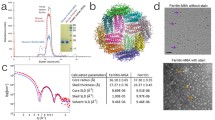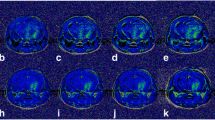Abstract
Purpose
The development of glioma therapy in clinical practice (e.g., gene therapy) calls for efficiently visualizing and tracking glioma cells in vivo. Human ferritin heavy chain is a novel gene reporter in magnetic resonance imaging. This study proposes hFTH as a reporter gene for MR molecular imaging in glioma xenografts.
Methods
Rat C6 glioma cells were infected by packaged lentivirus carrying hFTH and EGFP genes and obtained by fluorescence-activated cell sorting. The iron-loaded ability was analyzed by the total iron reagent kit. Glioma nude mouse models were established subcutaneously and intracranially. Then, in vivo tumor bioluminescence was performed via the IVIS spectrum imaging system. The MR imaging analysis was analyzed on a 7T animal MRI scanner. Finally, the expression of hFTH was analyzed by western blotting and histological analysis.
Results
Stable glioma cells carrying hFTH and EGFP reporter genes were successfully obtained. The intracellular iron concentration was increased without impairing the cell proliferation rate. Glioma cells overexpressing hFTH showed significantly decreased signal intensity on T2-weighted MRI both in vitro and in vivo. EGFP fluorescent imaging could also be detected in the subcutaneous and intracranial glioma xenografts. Moreover, the expression of the transferritin receptor was significantly increased in glioma cells carrying the hFTH reporter gene.
Conclusion
Our study illustrated that hFTH generated cellular MR imaging contrast efficiently in glioma via regulating the expression of transferritin receptor. This might be a useful reporter gene in cell tracking and MR molecular imaging for glioma diagnosis, gene therapy and tumor metastasis.







Similar content being viewed by others
References
Bulte JW, Kraitchman DL (2004) Iron oxide MR contrast agents for molecular and cellular imaging. NMR Biomed 17:484–499 doi:10.1002/nbm.924
Cohen B, Dafni H, Meir G, Harmelin A, Neeman M (2005) Ferritin as an endogenous MRI reporter for noninvasive imaging of gene expression in C6 glioma tumors. Neoplasia 7:109–117. doi:10.1593/neo.04436
Combs SE, Wagner J, Bischof M, Welzel T, Wagner F, Debus J, Schulz-Ertner D (2008) Postoperative treatment of primary glioblastoma multiforme with radiation and concomitant temozolomide in elderly patients. Int J Radiat Oncol Biol Phys 70:987–992 doi:10.1016/j.ijrobp.2007.07.2368
Cromer Berman SM, Kshitiz, Wang CJ, Orukari I, Levchenko A, Bulte JW, Walczak P (2013) Cell motility of neural stem cells is reduced after SPIO-labeling, which is mitigated after exocytosis. Magn Reson Med 69:255–262 doi:10.1002/mrm.24216
Das S, Marsden PA (2013) Angiogenesis in glioblastoma. N Engl J Med 369:1561–1563. doi:10.1056/NEJMcibr1309402
Feng Y, Liu Q, Zhu J, Xie F, Li L (2012) Efficiency of ferritin as an MRI reporter gene in NPC cells is enhanced by iron supplementation. J Biomed Biotechnol 2012:434878 doi:10.1155/2012/434878
Fleige G, Nolte C, Synowitz M, Seeberger F, Kettenmann H, Zimmer C (2001) Magnetic labeling of activated microglia in experimental gliomas. Neoplasia 3:489–499. doi:10.1038/sj/neo/7900176
Genove G, DeMarco U, Xu H, Goins WF, Ahrens ET (2005) A new transgene reporter for in vivo magnetic resonance imaging. Nat Med 11:450–454 doi:10.1038/nm1208
Grossman SA, Ye X, Piantadosi S, Desideri S, Nabors LB, Rosenfeld M, Fisher J, NABTT CNS Consortium (2010) Survival of patients with newly diagnosed glioblastoma treated with radiation and temozolomide in research studies in the US. Clin Cancer Res 16:2443–2449. doi:10.1158/1078-0432.CCR-09-3106
Harrison PM, Arosio P (1996) The ferritins: molecular properties, iron storage function and cellular regulation. Biochim Biophys Acta 1275:161–203
He X, Cai J, Liu B, Zhong Y, Qin Y (2015) Cellular magnetic resonance imaging contrast generated by the ferritin heavy chain genetic reporter under the control of a Tet-On switch. Stem Cell Res Ther 6:207 doi:10.1186/s13287-015-0205-z
Heyn C, Ronald JA, Mackenzie LT, MacDonald IC, Chambers AF, Rutt BK, Foster PJ (2006) In vivo magnetic resonance imaging of single cells in mouse brain with optical validation. Magn Reson Med 55:23–29 doi:10.1002/mrm.20747
Hsiao JK, Chu HH, Wang YH, Lai CW, Chou PT, Hsieh ST, Wang JL, Liu HM (2008) Macrophage physiological function after superparamagnetic iron oxide labeling. NMR Biomed 21:820–829. doi:10.1002/nbm.1260
Jin G, Zhou Y, Chai Q, Zhu G, Xu F, Liu F (2013) VP22 and cytosine deaminase fusion gene modified tissue-engineered neural stem cells for glioma therapy. J Cancer Res Clin Oncol 139:475–483 doi:10.1007/s00432-012-1347-3
Kedziorek DA, Muja N, Walczak P, Ruiz-Cabello J, Gilad AA, Jie CC, Bulte JW (2010) Gene expression profiling reveals early cellular responses to intracellular magnetic labeling with superparamagnetic iron oxide nanoparticles. Magn Reson Med 63:1031–1043 doi:10.1002/mrm.22290
Kim HS, Cho HR, Choi SH, Woo JS, Moon WK (2010a) In vivo imaging of tumor transduced with bimodal lentiviral vector encoding human ferritin and green fluorescent protein on a 1.5 T clinical magnetic resonance scanner. Cancer Res 70:7315–7324. doi:10.1158/0008-5472.CAN-10-0241
Kim HS, Oh SY, Joo HJ, Son KR, Song IC, Moon WK (2010b) The effects of clinically used MRI contrast agents on the biological properties of human mesenchymal stem cells. NMR Biomed 23:514–522. doi:10.1002/nbm.1487
Kim HS, Woo J, Lee JH, Joo HJ, Choi Y, Kim H, Moon WK, Kim SJ (2015) In vivo Tracking of dendritic cell using MRI reporter gene, ferritin. PLoS One 10:e0125291. doi:10.1371/journal.pone.0125291
Louie AY, Hüber MM, Ahrens ET, Rothbächer U, Moats R, Jacobs RE, Fraser SE, Meade TJ (2000) In vivo visualization of gene expression using magnetic resonance imaging. Nat Biotechnol 18:321–325. doi:10.1038/73780
Muckenthaler MU, Galy B, Hentze MW (2008) Systemic iron homeostasis and the iron-responsive element/iron-regulatory protein (IRE/IRP) regulatory network. Annu Rev Nutr 28:197–213. doi:10.1146/annurev.nutr.28.061807.155521
Ono K, Fuma K, Tabata K, Sawada M (2009) Ferritin reporter used for gene expression imaging by magnetic resonance. Biochem Biophys Res Commun 388:589–594. doi:10.1016/j.bbrc.2009.08.055
Pereira SM, Moss D, Williams SR, Murray P, Taylor A (2015) Overexpression of the MRI reporter genes ferritin and transferrin receptor affect iron homeostasis and produce limited contrast in mesenchymal stem cells. Int J Mol Sci 16:15481–15496 doi:10.3390/ijms160715481
Pierre VC, Allen MJ, Caravan P (2014) Contrast agents for MRI: 30+ years and where are we going? J Biol Inorg Chem 19:127–131. doi:10.1007/s00775-013-1074-5
Puttick S, Bell C, Dowson N, Rose S, Fay M (2015) PET, MRI, and simultaneous PET/MRI in the development of diagnostic and therapeutic strategies for glioma. Drug Discov Today 20:306–317 doi:10.1016/j.drudis.2014.10.016
Song C, Wang J, Mo C, Mu S, Jiang X, Li X, Zhong S, Zhao Z, Zhou G (2015) Use of ferritin expression, regulated by neural cell-specific promoters in human adipose tissue-derived mesenchymal stem cells, to monitor differentiation with magnetic resonance imaging in vitro. PLos One 10:e0132480. doi:10.1371/journal.pone.0132480
Swanson KR, Alvord EC Jr, Murray JD (2002) Virtual brain tumours (gliomas) enhance the reality of medical imaging and highlight inadequacies of current therapy. Br J Cancer 86:14–18. doi:10.1038/sj.bjc.6600021
Treffry A, Zhao Z, Quail MA, Guest JR, Harrison PM (1997) Dinuclear center of ferritin: studies of iron binding and oxidation show differences in the two iron sites. Biochemistry 36:432–441. doi:10.1021/bi961830l
Weissleder R, Simonova M, Bogdanova A, Bredow S, Enochs WS, Bogdanov A Jr (1997) MR imaging and scintigraphy of gene expression through melanin induction. Radiology 204:425–429. doi:10.1148/radiology.204.2.9240530
Weissleder R, Moore A, Mahmood U, Bhorade R, Benveniste H, Chiocca EA, Basilion JP (2000) In vivo magnetic resonance imaging of transgene expression. Nat Med 6:351–355 doi:10.1038/73219
Zhang F, Xie J, Liu G, He Y, Lu G, Chen X (2011) In vivo MRI tracking of cell invasion and migration in a rat glioma model. Mol Imaging Biol 13:695–701. doi:10.1007/s11307-010-0401-2
Zhang G, Jin G, Nie X, Mi R, Zhu G, Jia W, Liu F (2014) Enhanced antitumor efficacy of an oncolytic herpes simplex virus expressing an endostatin-angiostatin fusion gene in human glioblastoma stem cell xenografts. PLoS One 9:e95872. doi:10.1371/journal.pone.0095872
Zhao G, Arosio P, Chasteen ND (2006) Iron(II) and hydrogen peroxide detoxification by human H-chain ferritin. An EPR spin-trapping study. Biochemistry 45:3429–3436. doi:10.1021/bi052443r
Zhou Y, Jin G, Mi R, Dong C, Zhang J, Liu F (2014) The methylation status of the platelet-derived growth factor-B gene promoter and its regulation of cellular proliferation following folate treatment in human glioma cells. Brain Res 1556:57–66. doi:10.1016/j.brainres.2014.01.045
Zhu G, Su W, Jin G, Xu F, Hao S, Guan F, Jia W, Liu F (2011) Glioma stem cells targeted by oncolytic virus carrying endostatin-angiostatin fusion gene and the expression of its exogenous gene in vitro. Brain Res 1390:59–69. doi:10.1016/j.brainres.2011.03.050
Zurkiya O, Chan AW, Hu X (2008) MagA is sufficient for producing magnetic nanoparticles in mammalian cells, making it an MRI reporter. Magn Reson Med 59:1225–1231 doi:10.1002/mrm.21606
Acknowledgements
We thank Prof. XZ Chen for evaluating the MR molecular imaging (Radiology Department, Tiantian Hospital affiliated with Capital Medicine University). We also thank Prof. L Luo, GL Li, and L Xu (Pathological Department, Beijing Neurosurgical Institute) for the histological analysis of glioma specimens.
Author information
Authors and Affiliations
Corresponding authors
Ethics declarations
Funding
This work was supported by a Grant from the National Natural Science Foundation of China (Nos. 81271563, 81372354, 81302186 and 81672478), the Beijing Natural Science Foundation (No. 7151002), the Beijing Health System High-level Personnel Building Foundation (No. 2013-3-018), the Beijing Laboratory of Biomedical Materials Foundation (PXM2014_014226_000005), and the Beijing Municipal Administration of Hospitals’ Youth Programme (QML20150505).
Conflict of interest
The authors declare that they have no conflict of interest.
Ethical approval
Animal research was carried out in accordance with the recommendations in the Guide for the Care and Use of Laboratory Animals of the Beijing Tiantan Hospital, Capital Medical University. The experimental protocol was approved by the Committee on the Ethics of Animal Experiments of the Beijing Tiantan Hospital, Capital Medical University. All efforts were made to minimize the suffering of animal subjects.
Additional information
S. Cheng and R. Mi are co-authors.
Electronic supplementary material
Below is the link to the electronic supplementary material.
432_2017_2356_MOESM1_ESM.tif
S1 Fig. Western blot and histological analysis of intracranial glioma xenografts. (A) Expression of hFTH and EGFP in intracranially implanted xenografts was confirmed by western blot. (B) Prussian blue staining shows more iron accumulation in hFTH glioma xenografts (400×). (C) Immunofluorescent analysis of implanted xenografts expressing hFTH (red) or EGFP (green) alone (400×) (TIF 7386 KB)
Rights and permissions
About this article
Cite this article
Cheng, S., Mi, R., Xu, Y. et al. Ferritin heavy chain as a molecular imaging reporter gene in glioma xenografts. J Cancer Res Clin Oncol 143, 941–951 (2017). https://doi.org/10.1007/s00432-017-2356-z
Received:
Accepted:
Published:
Issue Date:
DOI: https://doi.org/10.1007/s00432-017-2356-z




